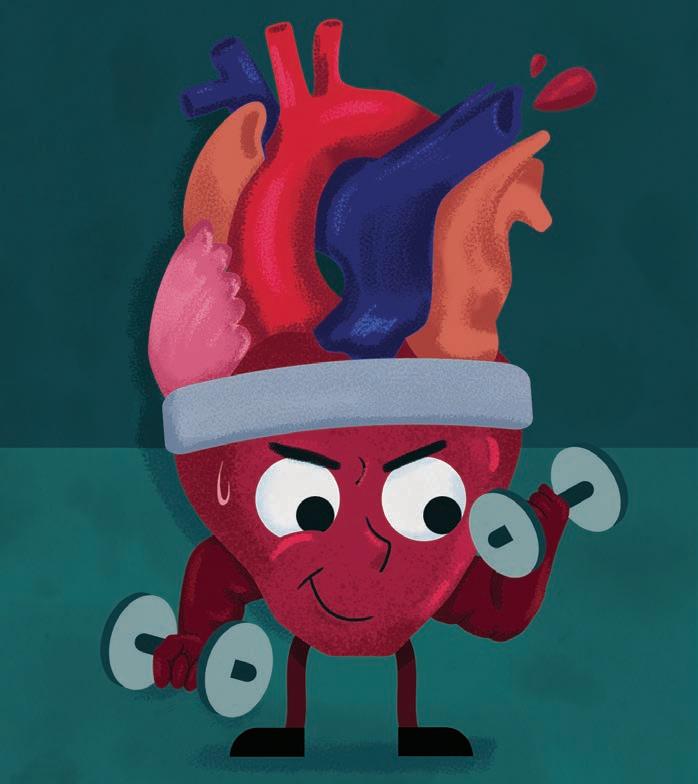
4 minute read
Reps for Your Heart
Pump up your muscles for better heart health
by Karen A. Jamrog / illustration by Victoria Marcelino
Aerobic exercise has long been one of the mainstays for reducing the risk of cardiovascular disease. But research in recent years has examined the role that strength training can play in heart health, and it turns out that pumping iron does more than boost biceps and tone thighs. It also fortifies the heart.
For sure, aerobic exercise such as running, walking or biking is an excellent way to help safeguard heart health, but if you want the best approach for cardiovascular fitness, don’t neglect strengthening exercises. Strength training — whether it comes though lifting dumbbells or barbells, using weight machines at a gym, or relying on body weight and gravity to provide resistance à la push-ups — delivers many of the same benefits that aerobic exercise does: It helps to protect and enhance cardiovascular health, improve mood and sleep, and assist with weight management, for example.
But the increase in muscle mass that comes with strength training conveys special benefits, boosting cardiovascular health in part by changing metabolism, which is the way the body converts food into energy. “We see as the muscles grow in size and metabolic capacity, as they improve, they do a better job using blood sugar [or] glucose,” says Jonathan Eddinger, M.D., F.A.C.C., a cardiologist-lipidologist at Catholic Medical Center’s New England Heart and Vascular Institute in Manchester. “Particularly in a diabetic or prediabetic or somebody who has [risk factors for heart disease, stroke and diabetes], strength training is very, very powerful in terms of improving that metabolism so that the ability to use the sugar is improved.”
Left untreated, elevated blood sugar can damage blood vessels, vital organs and nerves, and raise the risk of heart disease, stroke and a number of dangerous complications. Strength training over time can improve insulin sensitivity and blood glucose levels, and change body composition to one that has less fat and more muscle, which reduces a person’s risk for cardiovascular disease and diabetes, improves diabetes in those who already have the condition, and lowers blood pressure.
The metabolic changes that occur with strength training also mean you’ll burn more calories even when at rest and be better protected against harmful inflammation in the body. People who are obese, have diabetes, or have multiple risk factors for heart disease, stroke and diabetes “typically have more inflammation than somebody who doesn’t have those conditions,” Eddinger says, “and as you treat those conditions, the inflammation will get better. If you treat those conditions with exercise, which we think is probably one of the greatest medications — one of the greatest therapies for those conditions — you see not only the condition improve, but the inflammation improve with them.”
And, as it builds muscle mass and stamina, strength training makes the heart more efficient. “If you gain muscle and strength, your heart won’t have to pump as hard, to work as hard, whether you’re working out or walking to your mailbox,” says Chad Lawrence, A.P.R.N., manager of cardiovascular services and cardiac-pulmonary rehab at Concord Hospital. “You’ll be able to carry your body and move your body with ease rather than having to struggle under normal circumstances.”
Although studies show that gains in cardiovascular health can be achieved with strength training alone, the ideal exercise plan includes aerobic exercise as well as muscle-strengthening activities, so make both types of workouts part of your weekly workout mix. Respected organizations such as the American Diabetes Association and the American Heart Association recommend a combination of the two, and research data indicates that “the combination of the two, both aerobic and strength training, probably have additive benefit,” Eddinger says, so that they provide more health advantages together than they would individually.
Talk to your doctor before beginning a new exercise routine, but as a general rule of thumb, most people who don’t have health limitations should aim to strength train each of the body’s major muscle groups on at least two nonconsecutive days per week, while still including aerobic exercise at least five days a week, depending on the intensity of the activity.
You don’t have to become a bulked-up body builder to reap health gains; moderate resistance training will do the trick. The weight should be light enough that you can perform eight repetitions of the exercise, but heavy enough that you cannot properly perform more than 12 to 15 repetitions. If you don’t have access to strengthening equipment, use other methods to increase resistance on your muscles such as doing body-weight squats and lunges, or arm curls with soup cans or heavy grocery bags. Your muscles won’t know the difference, but they and your heart will thank you.
Facing the fear after a cardiac event
It’s no wonder that people who have experienced a cardiac event such as a heart attack are often fearful of overexerting themselves. “People are very apprehensive about any physical activity after a cardiac event,” says Chad Lawrence, A.P.R.N., manager of cardiovascular services and cardiac-pulmonary rehab at Concord Hospital. “They become afraid to do anything.”
Cardiac rehab, offered at many hospitals, provides expert support and guidance, and helps people regain their confidence so that they can safely exercise and reduce their risk of future heart trouble. “[We try] to slowly get their cardiac stamina and function back to where it was before,” Lawrence says, and help patients recognize the normal sensations that accompany exercise, such as an increased heart rate.
“We give them an appreciation of what all the symptoms in their chest are going to feel like [during workouts],” Lawrence says. “When they show up here, they’re on a heart monitor … on a treadmill or lifting weights or doing resistance training on our various machines, [and] they can experience these symptoms within their chest that are perfectly normal, and gain confidence that way.”










